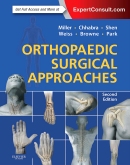|
|
|
| |
 |
|
|

|
 推薦指數:
推薦指數:





|
|
- 內容介紹
|
Orthopaedic Surgical Approaches, 2nd Edition
By Mark D. Miller, MD, A. Bobby Chhabra, MD, Shepard R. Hurwitz, MD, William M. Mihalko, MD, PhD and Francis H. Shen, MD
Expert Consult
Reference
504 Pages
Trim Size: 8 3/4 X 11 1/16 in
Imprint: Saunders
ISBN: 978-1-4557-7064-9
Copyright: 2015
Completely revised to feature a new, more modern design, Orthopaedic Surgical Approaches presents all of the latest imaging modalities and techniques used in orthopaedics today. This medical reference book captures the changes in this rapidly evolving field, equipping you with an expert, illustrative guide to the full array of common and contemporary surgical approaches, as well as the relevant regional anatomy. No matter what your level of training, this volume promises to be your go-to manual for acquiring new skills in the OR.
New to This Edition
Take advantage of the newest techniques and procedures with arthroscopic and minimally invasive approaches incorporated into each body region.
Utilize illustrations and information on surgical interventions and radiological landmarks as an introduction to each body region's relevant approaches.
Understand the hazards, particularly with regard to avoiding nerve damage, associated with each surgical approach.
View the complete contents and video clips online at Expert Consult!
Key Features
Access an up-to-date anatomic review of surgical approaches, including new advances in arthroscopy, mini-open, robotic, and computer-assisted techniques.
Easily reference key information with an organization based on anatomical region (including a review of regional anatomy, cross-sectional anatomy, landmarks and hazards) followed by procedure.
Visualize the full range of contemporary surgical approaches used in orthopaedics with over 1,000 original, full-color drawings and color photographs.
Gain insight into optimal patient positioning, see clear previews of anatomic landmarks and incisions, realize potential dangers of superficial and deep dissection, and learn techniques of closure.
|
|
|

